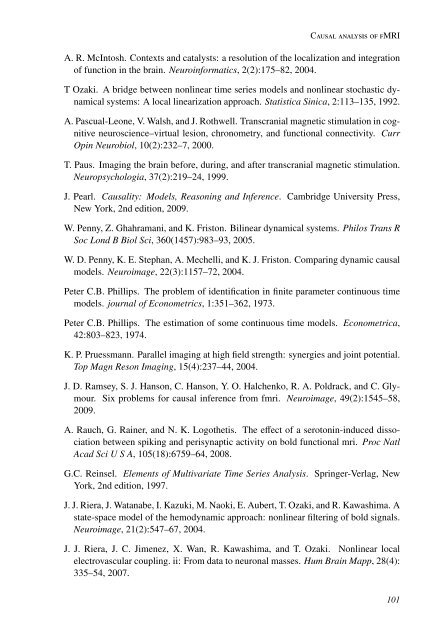Causality in Time Series - ClopiNet
Causality in Time Series - ClopiNet
Causality in Time Series - ClopiNet
Create successful ePaper yourself
Turn your PDF publications into a flip-book with our unique Google optimized e-Paper software.
Causal analysis of fMRIA. R. McIntosh. Contexts and catalysts: a resolution of the localization and <strong>in</strong>tegrationof function <strong>in</strong> the bra<strong>in</strong>. Neuro<strong>in</strong>formatics, 2(2):175–82, 2004.T Ozaki. A bridge between nonl<strong>in</strong>ear time series models and nonl<strong>in</strong>ear stochastic dynamicalsystems: A local l<strong>in</strong>earization approach. Statistica S<strong>in</strong>ica, 2:113–135, 1992.A. Pascual-Leone, V. Walsh, and J. Rothwell. Transcranial magnetic stimulation <strong>in</strong> cognitiveneuroscience–virtual lesion, chronometry, and functional connectivity. CurrOp<strong>in</strong> Neurobiol, 10(2):232–7, 2000.T. Paus. Imag<strong>in</strong>g the bra<strong>in</strong> before, dur<strong>in</strong>g, and after transcranial magnetic stimulation.Neuropsychologia, 37(2):219–24, 1999.J. Pearl. <strong>Causality</strong>: Models, Reason<strong>in</strong>g and Inference. Cambridge University Press,New York, 2nd edition, 2009.W. Penny, Z. Ghahramani, and K. Friston. Bil<strong>in</strong>ear dynamical systems. Philos Trans RSoc Lond B Biol Sci, 360(1457):983–93, 2005.W. D. Penny, K. E. Stephan, A. Mechelli, and K. J. Friston. Compar<strong>in</strong>g dynamic causalmodels. Neuroimage, 22(3):1157–72, 2004.Peter C.B. Phillips. The problem of identification <strong>in</strong> f<strong>in</strong>ite parameter cont<strong>in</strong>uous timemodels. journal of Econometrics, 1:351–362, 1973.Peter C.B. Phillips. The estimation of some cont<strong>in</strong>uous time models. Econometrica,42:803–823, 1974.K. P. Pruessmann. Parallel imag<strong>in</strong>g at high field strength: synergies and jo<strong>in</strong>t potential.Top Magn Reson Imag<strong>in</strong>g, 15(4):237–44, 2004.J. D. Ramsey, S. J. Hanson, C. Hanson, Y. O. Halchenko, R. A. Poldrack, and C. Glymour.Six problems for causal <strong>in</strong>ference from fmri. Neuroimage, 49(2):1545–58,2009.A. Rauch, G. Ra<strong>in</strong>er, and N. K. Logothetis. The effect of a seroton<strong>in</strong>-<strong>in</strong>duced dissociationbetween spik<strong>in</strong>g and perisynaptic activity on bold functional mri. Proc NatlAcad Sci U S A, 105(18):6759–64, 2008.G.C. Re<strong>in</strong>sel. Elements of Multivariate <strong>Time</strong> <strong>Series</strong> Analysis. Spr<strong>in</strong>ger-Verlag, NewYork, 2nd edition, 1997.J. J. Riera, J. Watanabe, I. Kazuki, M. Naoki, E. Aubert, T. Ozaki, and R. Kawashima. Astate-space model of the hemodynamic approach: nonl<strong>in</strong>ear filter<strong>in</strong>g of bold signals.Neuroimage, 21(2):547–67, 2004.J. J. Riera, J. C. Jimenez, X. Wan, R. Kawashima, and T. Ozaki. Nonl<strong>in</strong>ear localelectrovascular coupl<strong>in</strong>g. ii: From data to neuronal masses. Hum Bra<strong>in</strong> Mapp, 28(4):335–54, 2007.101





